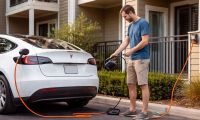GM is helping to drive a critical phase of vehicle-to-vehicle (V2V) and vehicle-to-infrastructure (V2I) tests in Ann Arbor, MI, that was announced two months ago and which launched today. The company is providing eight specially equipped Buick and Cadillac vehicles for a year of real-world testing. These vehicles are part of a larger fleet of passenger cars, commercial trucks and transit vehicles in the U.S. Dept. of Transportation’s Connected Vehicle Safety Pilot Model Deployment Program.
The research program is being led by the University of Michigan's Transportation Research Institute and is looking into vehicle-to-vehicle (V2V) and vehicle-to-infrastructure (V2I) technology to reduce collisions.
The National Highway Transportation Safety Administration (NHTSA) is scheduled to, in late 2013, look at the data to measure overall benefits of V2V and V2I technology. If successful there could be widespread deployment of V2V technology by 2020.
“Safety is our No. 1 priority, and this research could save lives and prevent injuries across America,” U.S. Transportation Secretary Ray LaHood said in a transportation department press release about the project. “With more than 30,000 people a year killed on our nation's roads, we need to keep looking for new ways to improve safety and reduce fatalities.”
What does V2V and V2I mean in practice? V2V allows vehicles to send data back and forth, directly between vehicles. This is basic information such as location, speed and direction of travel. The V2I part of the system shares information about traffic signals, road attributes and traffic conditions. In other words, with V2V vehicles have more information about the traffic around them, while with V2I vehicles gather higher level information on a larger scale.
By having information about speed and direction of surrounding cars, each car could have an automated system on-board to alert drivers of impending collisions, or to automatically modulate the car's speed to maintain a safe following distance. Some cars being sold today have a form of this capability already. For example, the 2013 Lexus RX 450h has a similar driver assist system, which gathers data using a milimeter wave radar system. What would be different between this and V2V is that cars equipped with radar are deducing the location and speed of other vehicles, whereas a V2V system would directly communicate that data.
The GM vehicles participating in the program will have production-viable integrated systems to send and receive information from other vehicles, and warning drivers when potential for a collision is detected.
There's no word on whether V2I features present a "big brother" scenario, such as each car sharing identity information with central computers so that authorities can track all movements of everyone who is driving.
Development of technologies like this are precursors to fully automated vehicles (a.k.a. RoboCars).
“Participating in this program will help GM and our research partners gain a more accurate, detailed understanding of V2V and V2I’s potential safety benefits,” said Nady Boules, GM Global R&D director of the Electrical and Control Systems Research Lab. “It is essential that common standards and security framework be established for V2V and V2I technologies so that vehicles from different automakers can communicate and interoperate with each other in a consistent manner.”
Ann Arbor was chosen as the test site partly because it is near the major U.S. automakers, and their engineers. The city road network has been instrumented with 29 roadside-equipment installations implementing 73 road-miles of V2I communications.
“This program will help GM determine a timeline for introducing V2V technology on our vehicles, globally, in the second half of this decade,” said Hariharan Krishnan, GM R&D technical fellow for Perception and Vehicle Control Systems. “It will take approximately another five years of market penetration for customers to truly benefit from the technology. Ultimately, V2V and V2I technologies stand to improve traffic safety and efficiency for many drivers.”












Comments
Sense airline already use
Permalink
Sense airline already use some of this technology. Why not install this in passenger trains first and then any equipment running on the same track as passenger trains. This would make an easy test study lab. The trains follow a track (vs a plane that has 3 directions of travel) and there is a much more limited number of trains (vs cars and trucks). This can also work the kinks out of the traffic controlled crossings and train signal lighting in an already controlled system.